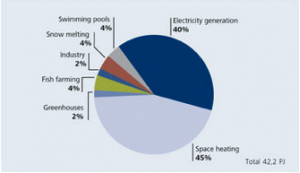
Iceland:
Iceland is one of the most dynamic volcanic regions in the world. Shaped by fierce natural forces, straddling the Mid-Atlantic Ridge where the activity of divergent tectonic plates brings heat and magma closer to the earth´s surface, Iceland holds enormous geothermal resources.
Geothermal power plants
There are five major geothermal power plants in Iceland and each of them has an important role; heating up the cold place of Iceland. The plants can produce about 26.2% of energy for the entire country, approximately 87% of heated water for all the establishments and houses, and 73.8% of the electricity provided from hydro power. That is really a very great deal for the locals. Imagine without the geothermal plants, Iceland would be as cold as Ice (literally) and no human being would ever tolerate to stay in such a place especially now when the climate is constantly changing and abruptly increasing or extremely decreasing. With the geothermal power plants in Iceland, it could be a huge change for the future to come in terms of energy supply.
Nesjavellir Power Plant
located at 177 m (581ft.) above sea level on the northeast side of Hengill, supplies 1,100 l/sec of 82-85°C hot water (181.4ºF). The water travels through a 27 km long pipeline (16.78 miles) to the city with a heat loss of only 2°C on the way. It is a combined heat and power plant and provides space heating and hot water for most of the Greater Reykjavik Area. It is the most powerful geothermal well in the world.
Svartsengi Power Plant
is situated in the south-west of the country, near the International Airport at Keflavik on the Reykjanes peninsula. As of 2012, it produces 75 MWe of electricity, and about 475 litres per second of almost boiling water (90°C). The water is also used to heat up the lake of the nearby Bláa Lónið (The Blue Lagoon).
Krafla Power Plant
is situated in the north-east corner of Iceland, near Lake Mývatn (Myvatn) and the volcano Krafla, from which it gets its name. It produces 60 MWe of electricity, with an expansion to 90 MWe planned.
Hellisheidi Power Plant
is located at Hengill, 11 km (7 miles) from the Nesjavellir Geothermal Power Plant. As of Oct 2011, the plant has a capacity of 303 MW of electricity and 133 MW of hot water; target capacity is 400 MW.
Reykjanes Power Plant,
located on the Reykjanes peninsula (15 km west of the Svartsengi Power Plant), produces 100 MWe, 850 GWhe/year, using steam from a reservoir at 290-320ºC. This is the first time that geothermal steam of such high temperature has been used to generate electricity on a large scale, and currently it’s the only high-temperature seawater-recharged geothermal system on a mid-ocean-ridge available for deep drilling anywhere in the world.
Iceland’s use of geothermal energy

shows the prevalent types of geothermal applications used in Iceland in 2013. Due to extensive district heating network and an impressive power generation capacity, space heating and electricity generation are the main uses of geothermal energy in Iceland, with the diverse industrial, agricultural, and recreational uses described earlier accounting for 17% of geothermal energy utilization in the country.
Generating electricity :with geothermal energy has increased significantly in recent years. As a result of a rapid expansion in Iceland’s energy intensive industry, the demand for electricity has increased considerably.

The figure shows the development from 1970-2013. The installed generation capacity of geothermal power plants totaled 665 MWe in 2013 and the production was 5.245 GWh, or 29% of the country’s total electricity production.
http://www.icelandontheweb.com/articles-on-iceland/nature/geology/geothermal-heat
http://www.northernlightsiceland.com/geothermal-heat-in-iceland/
http://insight.gbig.org/energy-generation-in-iceland-part-i-geothermal/